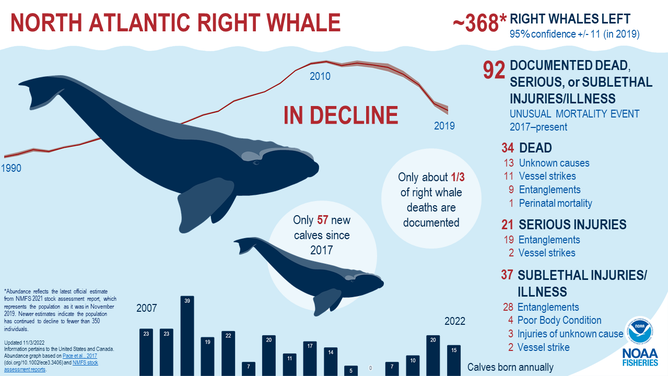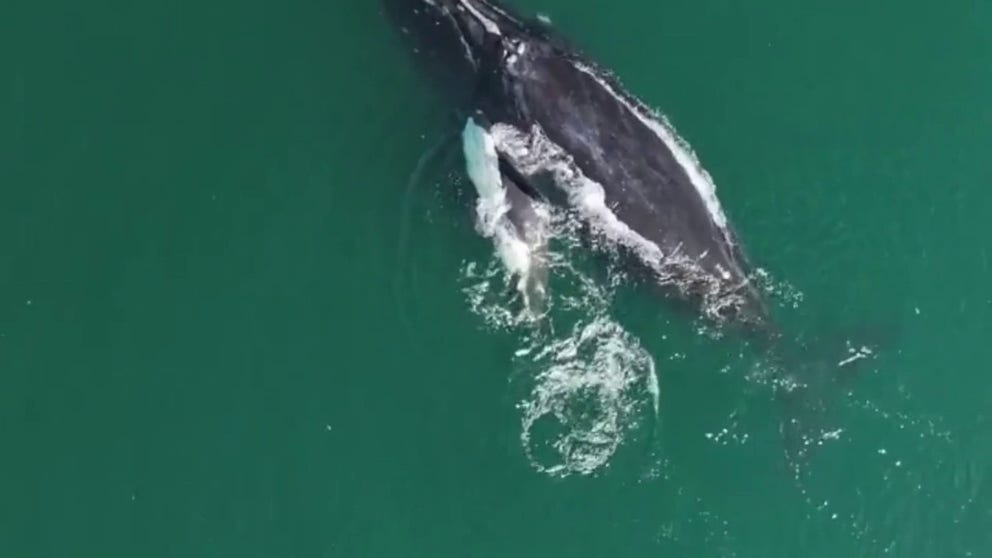3 endangered right whale calves spotted off Southeast coast
Around 16 right whale calves are born every year, according to NOAA data. The newborns help replenish the endangered population, estimated to be only around 350 whales.
North America right whale calf spotting first of season
Researchers from the Clearwater Marine Aquarium Research Institute spotted the whale and her calf off the coast of Georgia.
Researchers off the Southeast coast recently spotted three North Atlantic right whale calves bringing the early season tally to at least four juveniles of the endangered species sighted during the first weeks of the 2023 season.
The first calf was spotted off the coast of Georgia in early December, with other sightings happening in recent weeks off the coast of the Peach State.
Biologists said December usually starts the calving season, which can run through March. During this time, whales migrate to off the coasts of South Carolina, Georgia and Florida to give birth in the generally warmer waters of the western Atlantic Ocean.
The National Oceanic and Atmospheric Administration’s fisheries division reported the latest calf was spotted via a plane southeast of Ossawbaw Island, Georgia, in the company of mother "Porcia."
NOAA said "Porcia" is thought to be at least 26 years old and has had three known calves, but neither of the first two is thought to be alive due to fishing gear entanglement.
All of the recent calves appeared to be healthy, and NOAA did not report any unusual patterns with the sightings.
Human endangerment remains the top threat to the endangered species, and it is estimated that the population is only around 350.
‘MEDUSA’ SPOTTED WITH FIRST CALF OF THE NORTH ATLANTIC RIGHT WHALE SEASON
"Most recent population models show that the numbers are declining again for various reasons, including a slow reproduction rate, threats from entanglement in fishing gear, collisions with large vessels, and possibly other factors not yet identified," said Dr. James Powell, president and executive director of the Clearwater Marine Aquarium Research Institute.
The concerning downturn in the right whale population has been characterized as an Unusual Mortality Event, which triggers research and investigations into the potential causes.

North Atlantic Right Whale Population
(NOAA)
SHARKS AND TARPONS AND MANATEES, OH MY!
The NOAA Fisheries is examining increasing boating regulations along the U.S. East Coast that would implement speed restrictions and pave the way forward for new fishing technologies with the hope the changes could impact declines in the whale population.
"These two efforts are part of our North Atlantic Right Whale Road to Recovery, a strategy that encapsulates all of our ongoing work across the agency and in collaboration with our partners and stakeholders to conserve and rebuild the North Atlantic right whale population," Janet Coit, an administrator for NOAA Fisheries, said in a statement.
Beachgoers and boaters who spot right whales are required to stay at least 500 yards away and are encouraged to report sightings to 1-877-WHALE-HELP (877-942-5343).



